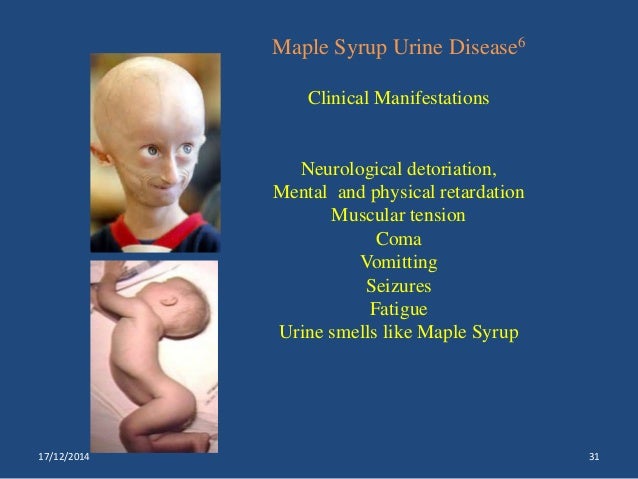

#LOCAL TREATMENT CENTERS FOR MAPLE SYRUP URINE DISEASE SERIES#
Developmental outcome in both series showed neurologic and developmental delays. The mortality rates were 27 and 21 %, respectively. Both groups had late diagnosis overall, and majority underwent peritoneal dialysis and acquired septicemia as a complication. ( 2008) described the two groups of Filipino MSUD patients diagnosed clinically prior to newborn screening, the first group involving 26 patients diagnosed from 1992 to 1998 and the second one composed of 21 patients diagnosed from 1999 to 2004. This confirmed that MSUD existed at a significantly higher prevalence in the Philippine newborn population, hence its inclusion in the newborn screening panel was proposed and subsequently implemented (Capistrano-Estrada & Jomento, 2009). Capistrano-Estrada reported that the number of confirmed MSUD cases (15) was almost twice as high as the number of phenylketonuria/hyperphenylalaninemia (9) confirmed cases as noted in the course of second-tier testing for confirmation of elevated phenylalanine by thin layer chromatography. 2004).īeing the most common IEM, maple syrup urine disease (MSUD) was added to the newborn screening panel in the last quarter of 2012 (Tayag, 2012). This may be a result of a founder mutation reported in the Filipino population wherein a novel deletion creating a new terminal exon of the dihydrolipoyl transacylase gene was found in 8 out of 13 families, with 5 of them being homozygous for the mutation (Silao et al. Based on the latest data from the Newborn Screening Reference Center in the Philippines, 20 neonates out of 1,104,823 screened have been confirmed to have the disorder translating to a cumulative incidence of 1:55,241 (NSRC, 2014). However, MSUD has been reported to be the most common inborn error of metabolism in the country. Worldwide, the estimated incidence of MSUD is 1:185,000 live births (Chuang & Shih, 2001 Nellis, et al., 2003). The golden period for the initiation of treatment before irreversible neurologic damage occurs is between 7 and 10 days (Strauss, 2006). Patients may develop seizures, and the progressive encephalopathy may lead to coma and death if left untreated (Chuang & Shih, 2001). Symptoms that may develop in the first week of life include vomiting, lethargy, poor suck, and irritability.

Patients with MSUD appear normal at birth but may present with burnt sugar or maple syrup odor of the cerumen and urine within the 12th hour of life. This enzyme deficiency causes the accumulation of the branched chain amino acids leucine, isoleucine, and valine (Chuang & Shih, 2001). Maple syrup urine disease (MSUD) is a rare inborn error of metabolism resulting from a deficiency in the branched-chain alpha-ketoacid dehydrogenase complex. Newborn screening has been proven to improve outcome in patients with MSUD but the success of the program in preventing disability is also dependent on improvements in other aspects of healthcare. Hospitals in difficult-to-reach areas must be equipped to handle critical metabolic cases when transfers are not possible.


Mechanisms of transfer of critically ill patients must be improved. Aside from early properly timed collection, improvement in other logistical concerns will also help in earlier diagnosis. The common challenges of MSUD management in a low-resource setting identified in this study were late diagnosis, lack of access to metabolic specialists and medical supplies, nosocomial septicemia, and protein deficiency. Several neurologic and non-neurologic complications have been observed during the follow-up of the patients. Out of the 24 diagnosed, 16 patients are alive, while eight have died. The most common complication during hospital admission was infection, needing intravenous antibiotics which were given to 21 of the patients. There were 24 patients diagnosed with maple syrup urine disease for the 2-year period. We described all patients with maple syrup urine disease patients diagnosed through newborn screening during its first 2 years of implementation and the challenges encountered during their medical management. MSUD has been reported to be the most common inborn error of metabolism in the Philippines.


 0 kommentar(er)
0 kommentar(er)
